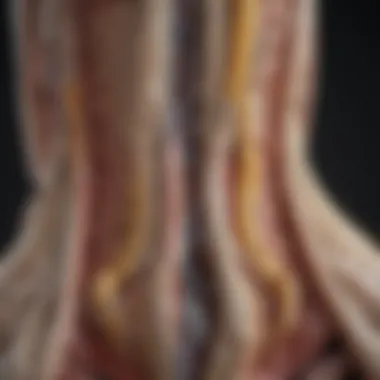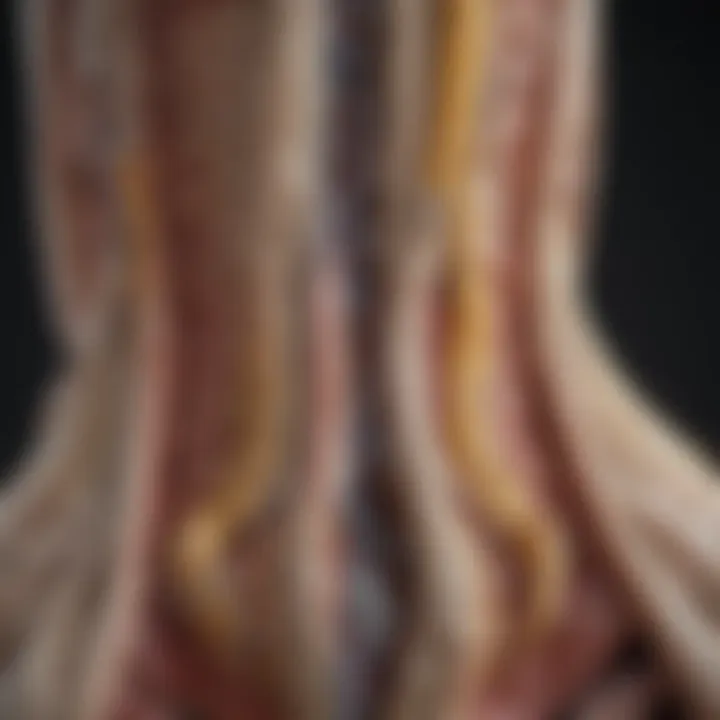Effective Strategies for Pinched Nerve Relief


Intro
Experiencing the sharp twinge of a pinched nerve can feel like a sudden, unwelcome visitor crashing your party. This often-persistent discomfort can range from an annoying ache to debilitating pain. Understanding the phenomenon of pinched nerves—and how to manage them—requires diving into physical anatomy and everyday life choices.
The nerve in question may be entrapped or compressed due to various factors, including poor posture, repetitive movements, and even injury. As these nerves pass through bony structures or tight muscles, they can be squished, leading to pain and other symptoms such as tingling or numbness.
In this article, we will embark on a journey through the maze of causes, symptoms, and most importantly, effective relief strategies for pinched nerves. Our target audience—health professionals, wellness coaches, nutritionists, fitness trainers, and mindfulness instructors—will find insights into holistic approaches and modern therapies.
This guide aims to equip you with the essential knowledge to tackle pinched nerve issues constructively, empowering not just your own well-being but also that of your clients.
Key Benefits
Understanding how to address pinched nerves can offer significant advantages not just physically but also mentally.
Physical Health Benefits
Alleviating the symptoms of a pinched nerve can lead to astonishing improvements in physical health. Not addressing the issue can lead to chronic pain and further complications like muscle atrophy or loss of function in the affected area. Here are some benefits of tackling this issue:
- Pain Reduction: Nerve compression can create a cycle of distress. Alleviating this can lead to immediate pain relief.
- Enhanced Mobility: By addressing the nerve issue, individuals often discover they can perform daily activities without discomfort.
- Preventative Care: Implementing preventive measures can shield against future occurrences, keeping you agile and active.
Mental Well-being Enhancements
Physical pain can severely affect mental health. Battling persistent discomfort can lead to irritability, anxiety, and even depression. Addressing these issues head-on often results in:
- Improved Mood: Overcoming pain can lift the weight off your shoulders, leading to better mental equanimity.
- Increased Focus: Relief from discomfort allows for clearer thought processes and an enhanced ability to concentrate on daily tasks.
- Empowerment: Knowing how to manage and prevent pinched nerves can boost self-confidence, enabling individuals to take charge of their health.
Practical Tips
In the realm of pinched nerve relief, incorporating practical strategies into one’s daily regimen can yield remarkable results.
Effective Meal Planning
Nutrition plays a pivotal role in mitigating inflammation and promoting nerve health. Here are some tips to create a diet that supports nerve recovery:
- Opt for anti-inflammatory foods: Add turmeric, ginger, and fatty fish like salmon to your meals. These can help curb inflammation that may exacerbate nerve issues.
- Stay hydrated: Adequate water intake promotes overall health, including nerve function.
- Limit processed sugars and fats: These can contribute to inflammation, slowing down recovery.
Quick and Efficient Workouts
Gentle movement is crucial for recovery. Engaging in specific exercises can strengthen muscles and relieve pressure from pinched nerves.
- Neck stretches: These promote flexibility and ease tension in the cervical region.
- Foam rolling: This technique helps release muscle tightness that may be compressing nerves.
- Low-impact activities: Walking or swimming can be excellent choices for gentle yet effective exercise that doesn’t stress the body excessively.
Remember, maintaining open lines of communication with healthcare professionals is crucial. Their guidance will help ensure that you are on the right track for recovery and wellness.
By embracing these strategies, the journey toward relief becomes clearer. Understanding the benefits and employing practical tips is the first step toward effectively addressing pinched nerves.
Understanding Pinched Nerves
Understanding pinched nerves is crucial for both prevention and treatment of symptoms that can significantly disrupt daily life. This section covers the nature of pinched nerves, their definitions, and the underlying causes. Recognizing these elements will aid health professionals, wellness coaches, nutritionists, fitness trainers, and mindfulness instructors in formulating effective strategies for relief.
Defining a Pinched Nerve
A pinched nerve occurs when surrounding tissues—like bones, cartilage, muscles, or tendons—apply excess pressure to a nerve. This can lead to discomfort, pain, numbness, or even weakness in various body parts. While the terms may sound clinical, they directly connect to the everyday experiences of many individuals, making it an essential topic for those in health-related fields. Understanding the definition is not just about knowledge; it’s about empathy for those affected, and the goal to improve their quality of life.
Common Causes of Pinched Nerves
Several factors can lead to pinched nerves, but here, we’ll emphasize key contributors that health professionals often encounter.
Repetitive movements
Repetitive movements are actions done frequently and can lead to overuse injuries, resulting in pinched nerves. Such movements could include typing or sports-related activities. The repetitive aspect tends to wear down tissues and change alignment, creating pressure on nerves. It’s a common pitfall; people often dismiss the discomfort until it escalates. The unique feature of repetitive movements is that they often result from occupational habits. Recognizing this can help in crafting interventions aimed at altering those daily activities.
Injury or trauma
Injuries from accidents or sports can lead to immediate damage to nerves or the surrounding structures, potentially pinching the nerves. The defining trait here is the intensity; sudden trauma creates an acute response that can be debilitating. It’s essential to address this aspect for timely management and recovery. The unique feature of injury or trauma is the unpredictability—one day you’re fit and fine, then suddenly, you’re faced with limitations. This reality makes understanding and addressing trauma vital for health regimes.
Inflammation and swelling
Inflammation due to conditions like arthritis, infections, or other health issues can cause swelling that pressures a nerve. When the body recognizes an injury, it sends fluids and inflammatory cells which leads to increased pressure. The key characteristic of inflammation is that it’s often the body’s protective response—even if it leads to unwanted side effects like nerve compression. The unique aspect here is the duality of inflammation; it is necessary for healing but can inadvertently lead to chronic issues if not managed. In our discussions revolving around treatment, differentiating between healing and pressure becomes essential.
Poor posture
Poor posture is often overlooked but poses a significant contribution to nerve compression. Slumping at a desk or cradling a phone can lead to abnormal spinal alignment, pressing on nerves in the neck or back. The connection between poor posture and nerve issues illustrates a simple corrective measure with massive consequences for patient welfare. The singular advantage of focusing on posture is the wide array of easy adjustments one can advocate for. If we can educate individuals on this simple change, the long-term benefits are evident. Challenging habits, however, often meets resistance, requiring continuous reinforcement from professionals.
Understanding the causes of pinched nerves helps tailor preventive measures and treatments. It’s a crucial step toward relief and long-term health.
Symptoms of a Pinched Nerve
Understanding the symptoms of a pinched nerve is crucial for both diagnosis and treatment. Recognizing these signs early can allow individuals to seek timely care, reducing the risk of further complications. Symptoms can be quite diverse and often interrelate. Physical discomfort may manifest alongside emotional challenges, illustrating the breadth of the impact a pinched nerve can have on one's daily life. This section delves into both the physical and psychological symptoms associated with pinched nerves, shedding light on how they can inform treatment choices and preventative measures.
Recognizing Physical Signs
Numbness and tingling
One of the hallmark signs of a pinched nerve is numbness and tingling, also known as paresthesia. This sensation typically surfaces in the affected area, whether it be an arm, leg, or elsewhere, signaling that the nerve is under undue pressure. The interesting thing is that this symptom can be transient or persistent; some folks might experience it for just a few minutes while others live with it for ages. Understanding this aspect is beneficial because it serves as an immediate red flag, suggesting the necessity for further investigation.
In essence, the key characteristic of numbness and tingling is its unpredictability, often appearing without notice. This can be particularly troublesome when it interferes with everyday tasks or activities. On the flip side, its irregular nature means that it can easily be overlooked until it escalates into something more severe.
Sharp pain
The next symptom that often commands attention is sharp pain. This pain tends to strike like lightning—sudden and acute, catching you off guard. Unlike a dull ache that may give you time to react, sharp pain makes its presence known right away, drawing immediate focus to the affected area.
What makes sharp pain particularly noteworthy is its ability to radiate. For instance, a nerve pinched in the neck can lead to pain shooting down the arm. Recognizing this symptom is crucial because it often signals the urgency for medical intervention. However, the down side is that sharp pain can cloud judgment, possibly leading individuals to ignore the underlying issue in favor of temporary relief methods.
Weakness in limbs


Lastly, there's weakness in limbs, a symptom that can range from mild to profoundly disabling. This type of weakness usually indicates a more severe impact on the nerve's function. Individuals may find it difficult to grip objects or may notice that their limbs tire more quickly than usual.
The unique feature of this symptom is that it can affect one side of the body differently than the other, depending on where the nerve compression is taking place. While weakness clearly signals that something is wrong, it also emphasizes the need for targeted treatment to restore strength and function. Once again, it's imperative to catch this symptom early on before it leads to more serious long-term complications.
Psychological Impacts
Stress and anxiety
The emotional side of dealing with a pinched nerve can't be overlooked. Stress and anxiety often form a companion piece to the physical symptoms. As one battles through pain and discomfort, worries about recovery and daily functioning can spiral. This aspect complicates the situation, creating a feedback loop where physical symptoms exacerbate emotional distress.
Recognizing this connection can lead to better management strategies and paves the path for a more holistic approach to treatment. Ignoring the psychological piece is a recipe for longer recovery times.
Impact on sleep quality
Sleep is often disrupted when dealing with a pinched nerve. The impact on sleep quality can be debilitating, making it difficult to find a comfortable position. Pain, discomfort, or emotional stress may turn a good night’s sleep into a restless night filled with tossing and turning.
This symptom’s unique feature is its dual effect. Not only does lack of sleep impair daily functioning and productivity, but it can also amplify feelings of pain and irritation, creating cyclical challenges for recovery. Addressing sleep quality may offer significant relief, making it an essential aspect of any comprehensive treatment plan.
By understanding the symptoms associated with a pinched nerve, individuals empower themselves to make well-informed decisions regarding their health, seeking out the right interventions to restore balance and wellness.
Diagnosis of Pinched Nerves
Diagnosing a pinched nerve is a crucial step in understanding how to effectively address it. This process not only identifies the issue but also helps tailor a treatment plan that meets individual needs. Knowing what’s at play within the body allows healthcare professionals to make informed decisions. Moreover, a proper diagnosis can relieve anxiety that often accompanies unexplained pains and discomforts.
A thorough diagnosis often starts with an assessment of the patient's medical history and physical examination, pinpointing any specific symptoms they may be experiencing. This serves as the bedrock for identifying which body parts are affected and how far the problem goes. Next up are imaging techniques, which can validate findings and provide a clearer picture of the underlying structures at play.
Understanding the significance of these diagnostic measures can empower patients. When one is in the know about what’s happening in their body, it tends to ease the feeling of being at loose ends.
Medical History and Physical Examination
The first point of contact in diagnosing a pinched nerve typically involves collecting a detailed medical history. Physicians will inquire about past injuries, workload, and lifestyle, including details about any symptoms like numbness or shooting pain. This conversation helps lay the groundwork for understanding the potential triggers of a pinched nerve.
Upon completion of medical history, the physician usually proceeds to a physical examination. This hands-on approach allows for valuable insights into nerve function. Patients may be asked to perform simple movements or resist mild tension to gauge if any specific actions exacerbate symptoms. Engaging directly with these physical behaviors can shine a light on whether a nerve is indeed pinched or if other factors may be in play.
Imaging Techniques
Following history-taking and examination, imaging techniques serve as the next step. They are pivotal in providing a full view of the nerves, surrounding tissues, and bony structures. Each imaging type has its strengths and can reveal different aspects of the condition.
MRI Scans
Magnetic Resonance Imaging, or MRI scans, have gained traction for diagnosing pinched nerves due to their capacity for providing detailed images of soft tissues. This technique stands out because it doesn’t rely on radiation, using magnetic fields instead. Its ability to depict nerve tissues and the surrounding environments often makes it a go-to for healthcare providers.
However, a downside might be the cost and availability of MRIs, which can sometimes be limited based on one’s healthcare provisions. Still, the accuracy and depth of the information it provides often justify its use, especially when results guide treatment plans effectively.
X-Rays
On the other hand, X-rays play a more straightforward role in diagnosis. They mainly focus on the bones, so for a pinched nerve, they can help reveal any bone spurs or misalignments that might be contributing to the issue. Their affordability and quick results make them a popular choice for initial evaluations, yet they don't provide much insight into soft tissue that might be at fault.
Although X-rays are helpful, their limitation lies in their inability to visualize nerves and soft tissue injuries comprehensively. This is why they are frequently combined with other imaging techniques for a more thorough assessment.
CT Scans
Lastly, CT scans offer a hybrid solution, combining the benefits of both MRI and X-rays. They provide detailed images of bones and soft tissues, making them beneficial for diagnosing pinched nerves. A notable characteristic of CT scans is their speed; they can deliver images quickly, which can be particularly advantageous in emergency situations.
However, it is worth noting that CT scans involve exposure to a certain amount of ionizing radiation, which raises some health concerns for frequent use. In this regard, their application is often considered with caution and typically as a follow-up to MRI or other less invasive imaging methods.
Understanding these diagnostic avenues empowers individuals to take informed steps toward their health. They can feel more connected to the process and less like passengers in their own healthcare journeys.
Conservative Treatment Options
Addressing the discomfort associated with a pinched nerve often begins with conservative treatment options. This approach prioritizes non-invasive strategies that focus on alleviating pain while promoting recovery. Not only can these methods provide immediate relief, but they also lay the groundwork for long-term management of nerve-related issues. The primary benefits of conservative treatments include minimal side effects, accessibility, and the ability to tailor interventions to individual needs. While more severe cases may eventually require interventions, starting with conservative measures can often yield substantial results.
Physical Therapy Techniques
Stretching exercises
Stretching exercises play a vital role in the healing process of a pinched nerve. These movements enhance flexibility and promote blood flow to the affected area, which is essential for nerve recovery. A key characteristic of stretching exercises is their ability to gently mobilize tissues, reducing stiffness and easing pressure on the nerve. This makes it a popular choice among health professionals looking for effective, low-risk interventions.
One unique feature of stretching exercises is their inherent adaptability; they can be modified to suit individual capabilities and limitations. This means that regardless of one’s fitness level, stretching exercises can be introduced safely into a rehabilitation program. A consideration, however, is that for individuals with significant injury or acute pain, care must be taken to avoid overstretching, which could worsen the condition.
Strengthening routines
Strengthening routines also hold significant importance in recovering from a pinched nerve. They contribute to overall stability and support in the affected area, reducing the risk of future injuries. A key feature of such routines is their focus on building muscle strength around the injured nerve. This support helps alleviate pressure and restore proper function over time.
Strengthening exercises stand out due to their long-term benefits; consistent engagement can lead to enhanced overall physical resilience and improved posture, which is crucial for preventing recurrence. However, it is important to note that initiating these routines should be done under professional supervision, especially in the earlier stages of recovery, to ensure safety and effectiveness.
Medication for Pain Management
Over-the-counter options
Over-the-counter options provide immediate, accessible relief for individuals dealing with a pinched nerve. Common choices such as ibuprofen or acetaminophen are often recommended to help reduce inflammation and alleviate pain. The key characteristic of these medications is that they can be obtained without a prescription, making them readily available for anyone experiencing discomfort.
One unique aspect of over-the-counter pain relievers is their wide acceptance among patients; most people are familiar with them and may have used them for other conditions. However, individuals should be cautious not to over-rely on these medications. Extended use can lead to potential side effects or masking underlying issues that might require more extensive treatment.
Prescription medications
For those who find over-the-counter drugs insufficient, prescription medications offer alternative solutions. These might include stronger anti-inflammatory medications or muscle relaxants prescribed by a healthcare provider. A significant advantage of prescription medications is their targeted approach; healthcare professionals can tailor recommendations based on the patient’s specific condition and response.
One unique feature of prescription medications is their potency, which can lead to effective pain relief when lower-tier options fail. However, this comes with a caveat; increased effectiveness can also lead to a higher risk of side effects or dependency, so careful monitoring and consultation with a physician are crucial. Patients must weigh the benefits alongside potential risks when considering these options for managing pain associated with pinched nerves.
Advanced Therapeutic Approaches
In tackling the issue of pinched nerves, one must consider advanced therapeutic approaches. These methods serve as additional tools in the toolbox, particularly when conservative treatments prove insufficient. The importance of these advanced interventions lies in their targeted nature, which aims to alleviate symptoms and restore function more deeply than conventional methods.
Advanced therapeutic approaches can greatly enhance a patient’s quality of life, providing relief that allows them to engage in daily activities without discomfort. A detailed understanding of these methods not only empowers healthcare professionals in their practice but also informs patients on what to expect as they navigate treatment options.


Injections and Nerve Blocks
One key advanced approach includes injections and nerve blocks. These are primarily utilized to relieve pain and reduce inflammation in the affected area. Corticosteroid injections, for instance, are commonly administered to combat the swelling that contributes to nerve compression.
The benefits of nerve blocks extend beyond immediate pain relief. They can serve as a diagnostic tool, helping to identify the exact source of discomfort. This targeted response makes it possible for patients to engage in rehabilitation more effectively, ultimately expediting recovery.
However, like any medical intervention, injections are not without risks. Complications, albeit rare, can include infection or allergic reactions. Therefore, these options should be discussed thoroughly with healthcare providers to weigh the benefits and risks based on individual circumstances.
Surgical Interventions
Advanced therapeutic approaches also encompass surgical interventions, which may be necessary for severe cases where conservative methods have failed. Surgical options often provide definitive solutions by addressing the underlying causes of nerve compression directly.
Decompression Surgery
Decompression surgery is a popular choice in the realm of surgical interventions. This procedure is designed to relieve pressure on the affected nerve by removing the tissues or bone compressing it. This method stands out due to its effectiveness in providing long-term relief from symptoms associated with pinched nerves.
One key characteristic of decompression surgery is its ability to restore normal nerve function. By alleviating pressure, the nerve can begin to heal, leading to a significant reduction in pain and discomfort.
Among its advantages, decompression surgery often results in a quick recovery time and a high success rate for symptom control. Nevertheless, potential disadvantages include the inherent risks of surgical procedures, including infection, bleeding, and the possibility of not achieving the desired results. Thus, it is crucial for patients to engage in thorough discussions with their surgeons about the potential outcomes.
Repair Procedures
Another noteworthy surgical intervention includes repair procedures, which focus on treating damaged nerves directly. This may involve suturing or grafting nerves to restore their integrity.
Repair procedures are beneficial for patients who experience significant nerve damage that could lead to permanent impairment if not addressed. What makes this approach unique is its potential not just for pain relief but also for restoring lost function.
However, these procedures come with their own set of considerations. The key advantages are their targeted nature and the possibility of functional recovery. On the flip side, there are disadvantages such as longer rehabilitation times and the uncertain outcomes dependent on factors like the extent of nerve damage.
Ultimately, the choice between surgical options requires careful consideration of individual circumstances, potential benefits, and a discussion of goals with healthcare professionals.
Lifestyle Modifications for Prevention
Addressing pinched nerves isn’t just about treatment; it’s also about prevention. This section will detail how small, daily choices can play a crucial role in maintaining nerve health. By embracing certain lifestyle modifications, individuals can effectively reduce their risk of developing pinched nerves in the first place.
Ergonomics in Daily Life
Good ergonomics are pivotal for preventing discomfort, especially when it comes to your workspace and daily activities. Properly set up environments can minimize strain on the body, allowing you to maintain a healthier posture and lessening the likelihood of nerve compression.
Proper sitting posture
One of the most significant aspects of ergonomics is proper sitting posture. When sitting, your back should be straight and your shoulders relaxed, keeping your ears in line with your shoulders. This alignment helps reduce strain on the neck and upper spine, which could aggravate or cause a pinched nerve.
Key characteristic: A notable feature of proper sitting posture is the support it provides to the lumbar region. Using a chair that supports your lower back can make a world of difference.
Reasons for its popularity:
This is a popular choice because it’s straightforward and can be applied in various settings, from home offices to corporate workspaces.
Advantages:
The primary advantage of maintaining proper sitting posture is its role in decreasing tension in the back and neck, ultimately reducing the risk of nerve issues.
Disadvantages:
However, it requires constant awareness and adjustments, which some may find challenging, especially during long work hours.
Workstation setup
Equally important is the effective setup of your workstation. This includes proper alignment of your computer screen, keyboard, and other equipment. Ideally, your screen should be at eye level, approximately an arm's length away. This positioning helps prevent neck strain that often comes from looking down or craning your neck.
Key characteristic:
A well-set workstation promotes a neutral sitting position, which is beneficial in avoiding repetitive strain.
Reasons for its efficacy:
This is a sought-after setup as it addresses immediate discomfort while working and positions oneself correctly for various tasks.
Unique features:
Adjustable chairs and desks can enhance a workstation, allowing for personalization that accommodates your body, which is instrumental in preventing pinched nerves.
Advantages and disadvantages:
While a well-configured workstation offers significant benefits, it might require an upfront investment in ergonomics that some employees or individuals might shy away from initially.
Exercise and Wellness Strategies
Incorporating regular wellness strategies into your routine can be a game changer for overall health and can help in reducing the likelihood of pinched nerves.
Regular physical activity
Engaging in regular physical activity enhances strength and flexibility, aiding the body in maintaining proper alignment. Aim for a healthy balance of aerobic exercises, strength training, and stretching.
Key characteristic:
What stands out about regular physical activity is its capacity to improve circulation and nutrient delivery to nerve tissues.
Why it's beneficial:
The popularity of exercise as a preventive measure lies in its multifaceted benefits—beyond nerve health, it boosts mood and energy.
Unique feature:
It can seamlessly integrate into any daily routine, from short 10-minute walks to more structured workout plans.
Advantages and disadvantages:
Though the advantages are apparent, some may find challenges in committing time to regular exercise amidst a busy lifestyle.
Mindfulness and stress reduction
Lastly, adapting mindfulness and stress reduction techniques can have a profound impact on nerve health. Practices like yoga, meditation, and deep breathing not only help keep the body relaxed but also contribute to mental wellbeing.
Key characteristic:
Mindfulness promotes awareness of one's body, helping to identify tension spots that could lead to nerve problems.
Reasons for its inclusion:
The growing popularity of mindfulness practices stems largely from their proven effects on reducing physical and mental stress levels, both of which can exacerbate discomfort.
Unique feature:
Mindfulness offers an easy, accessible way for individuals to engage with their health, transcending mere exercise.
Advantages and disadvantages:
While the benefits are numerous, some might find it challenging to maintain a consistent mindfulness practice, especially amidst a chaotic lifestyle.
Lifestyle modifications are more than just habits; they become essential practices that foster long-term nerve health and overall physical wellbeing.
Alternative Therapies and Holistic Practices
Exploring alternative therapies and holistic practices provides invaluable insight into addressing pinched nerves, augmenting traditional medical interventions. While medication might offer some temporary relief, many individuals look to these practices to manage pain and discomfort more sustainably. These therapies focus not only on the symptoms but on nurturing overall wellbeing—a vital factor especially for those facing chronic issues.


Benefits of Alternative Therapies:
- Holistic Approach: They treat the whole person, not just the condition.
- Complement to Conventional Methods: Can work alongside medical treatments, enhancing their effectiveness.
- Empowerment: Individuals often find that actively engaging in their healing process instills a sense of control and optimism.
However, it's essential to choose therapies wisely, as personal responses vary. Some may experience significant improvement, while others might find minimal benefits. Thus, staying informed and consulting with knowledgeable health professionals is crucial.
Acupuncture and Chiropractic Care
Acupuncture, rooted in Traditional Chinese Medicine, centers on balancing the body's energy, known as Qi. Needles are inserted into specific points, which can alleviate pain related to pinched nerves. Clinical studies have shown that acupuncture may help reduce pain and inflammation effectively, making it a preferred choice for many navigating nerve issues.
Chiropractic care, on the other hand, involves hands-on spinal manipulation and other manual techniques. A chiropractor can realign the spine and reduce nerve compression, potentially easing symptoms. Regular sessions can improve flexibility and support healthy posture, which is important for those prone to pinched nerves.
Both practices encourage individuals to explore their body's signals, fostering a greater connection to their physical state. However, consulting with healthcare professionals before embarking on these therapies is key
Massage as a Relief Technique
Massage therapy stands as another effective technique for managing pinched nerves. Kinds of massages such as deep tissue and trigger point therapy aim to ease muscle tension that may compress nerves. Regular massages can increase blood flow to the affected area and promote relaxation, reducing stress and anxiety often associated with chronic pain.
It is essential to communicate with the therapist about specific pain areas to tailor the massage effectively. Some techniques to consider include:
- Swedish Massage: Good for overall relaxation and reducing tension.
- Myofascial Release: Focuses on the connective tissues and can alleviate tightness.
- Sports Massage: Particularly useful for those engaged in physical activities that might lead to nerve issues.
Incorporating these therapies into a regular wellness routine may help individuals reclaim their quality of life, paving the way for a more balanced and healthier existence. As always, the amalgamation of alternative practices with conventional medicine can create a more comprehensive approach to managing nerve pain.
The Role of Nutrition in Nerve Health
Nutritional choices play a pivotal role in maintaining nerve health and overall well-being. It can be easy to underestimate how what’s on your plate impacts nerve function, but the right foods are as crucial as the correct therapies when it comes to alleviating the discomfort caused by a pinched nerve. By incorporating specific dietary elements, one can optimize nerve recovery while also diminishing inflammation that exacerbates symptoms. This section delves into practical dietary considerations to support nerve health, emphasizing how adhering to a balanced diet can make a significant difference for those suffering from nerve issues.
Anti-inflammatory Diet
An anti-inflammatory diet is designed to lower inflammation in the body, a significant factor in the discomfort and pain associated with pinched nerves. This eating approach not only promotes nerve healing but also supports general health. Here are some core principles and foods to consider:
- Whole Grains: Opt for brown rice, quinoa, and whole wheat bread instead of refined grains. Whole grains are rich in fiber and can play a role in reducing inflammation.
- Fruits and Vegetables: Particularly, select a variety of colors in fruits and vegetables, such as berries, oranges, spinach, and kale. These foods are loaded with antioxidants that combat oxidative stress.
- Healthy Fats: Incorporating sources of Omega-3 fatty acids, like salmon, walnuts, and flaxseeds, can help in lowering inflammation levels.
- Nuts and Seeds: Almonds and chia seeds provide not just healthy fats but also essential nutrients that support overall nerve function.
People often find it beneficial to limit or eliminate processed foods, sugars, and saturated fats, which can trigger inflammation rather than reduce it. Adopting these habits shifts the body towards a state less prone to issues like pinched nerves.
"An anti-inflammatory diet is a key factor that could serve to buffer not just nerve pain but a myriad of chronic conditions," points out nutritionists emphasizing the power of food as medicine.
Essential Nutrients for Nerve Recovery
Specific nutrients are especially vital during nerve recovery. They help steer the body towards mending and restoring nerve functions more effectively. Here’s a breakdown:
- Vitamin B12: Critical for nerve health. Found in foods like eggs, fish, and fortified cereals, a deficiency in B12 can lead to serious nerve damage.
- Vitamin D: Plays a significant role in nerve health and can be absorbed through sun exposure or dietary sources like fatty fish and fortified milk.
- Magnesium: An underappreciated nutrient that supports muscle and nerve function. Sources include spinach, nuts, and whole grains.
- Antioxidants: Vitamins C and E help protect nerves from damage caused by free radicals. Citrus fruits for Vitamin C and nuts for Vitamin E can easily be included in meals.
Incorporating these essential nutrients can aid in lowering symptoms associated with a pinched nerve, pushing the recovery process in a more positive direction. Tailoring a diet rich in these components ensures that nerve health remains a priority, fostering an environment conducive to healing.
Long-term Outlook for Pinched Nerve Patients
Understanding the long-term outlook for individuals dealing with pinched nerves is vital for both healthcare providers and patients. A pinched nerve can have lasting effects not only on physical health but also on mental well-being. Knowing what lies ahead allows individuals to approach their conditions with informed expectations and effective strategies. The recovery process can vary significantly among patients, influenced by factors like the severity of the compression and any underlying health issues.
For many, the path to recovery is gradual. Most will experience improvement over weeks to months, largely hinging on proper management and adherence to recommended treatments. Only a subset may face enduring complications, which can include chronic pain or mobility issues. Recognizing the availability of various therapeutic options empowers patients to adopt proactive measures in their recovery journey.
Understanding Recovery Times
Recovery times for pinched nerves can be as varied as the conditions that precipitate them. Generally, nerve irritation can take a few weeks to heal but full recovery might stretch several months, especially if the nerve was consistently compressed. Engaging in physical therapy can expedite recovery by strengthening the surrounding muscles and alleviating some of the pressure.
A few key points to consider when evaluating recovery times include:
- Severity of Injury: Milder cases often recover quicker; severe conditions may necessitate prolonged care.
- Patient Compliance: Adhering to a prescribed treatment plan can drastically affect healing times. Individuals neglecting their exercise and stretching routines tend to prolong their discomfort.
- Underlying Health Conditions: Issues like diabetes or obesity can complicate recovery, necessitating more intensive management strategies.
It's essential for patients to have open dialogues with their healthcare providers regarding their recovery trajectories.
Identifying Recurring Issues
Recurring issues after a pinched nerve can be a frustrating reality for many. It's not uncommon for a pinched nerve to resurface if the root causes are not addressed or if proper care isn't taken to prevent recurrence. In many cases, patients may find symptoms re-emerging after what seemed like a full recovery.
To mitigate future problems, focusing on the following areas is critical:
- Posture Awareness: Many individuals unknowingly maintain poor posture while working or sitting which places undue stress on their nerves. Regularly checking and correcting one’s posture can be significant in preventing recurrence.
- Ergonomic Adjustments: Ensuring that workspaces are set up correctly can help alleviate strain on nerves. Simple changes, like adjusting chair height or monitor placement, can make a world of difference.
- Ongoing Exercise: Maintaining a regular exercise routine not only strengthens muscles but also improves flexibility, reducing the chance of recurrence.
"Being proactive in managing your health today can save you from navigating pain and discomfort tomorrow."
In summary, keeping an eye on recovery timelines and being cognizant of factors that lead to recurring issues is imperative for anyone dealing with a pinched nerve. By taking measured steps and collaborating closely with healthcare professionals, patients can pave the way for a smoother healing process and cultivate a better quality of life.
Consultation and Support Resources
Consulting the right resources when grappling with a pinched nerve is absolutely crucial. Having a well-rounded support system can make all the difference in navigating the complexities of diagnosis, treatment, and long-term management. This isn't just about having a one-time appointment with a healthcare professional; it�’s about forming a continuous partnership designed to guide you through various stages of care.
For individuals dealing with pinched nerves, knowledge is power. Access to a variety of consultation and support resources not only aids in understanding the condition but can also reveal paths for effective relief. These can come in various forms, from professional healthcare advice to community support networks. The myriad of options available fosters a proactive rather than reactive approach to management.
"Investing in the right support can turn the tide from suffering in silence to thriving in recovery."
Finding the Right Healthcare Provider
When it comes down to selecting the right healthcare provider, there are several key aspects to keep in mind. You want a professional who understands the intricacies related to your specific situation. This applies not only to doctors but also to physical therapists, chiropractors, and specialized pain management practitioners.
Here are some important points to consider:
- Credentials: Always check their qualifications. A practitioner with ample experience in treating pinched nerves can provide tailored care suited to your needs.
- Referrals and Recommendations: Talk to friends, family, or other healthcare professionals. Personal experiences can offer invaluable insights.
- Compatibility: Establishing a good rapport is crucial. You need to feel comfortable enough to communicate openly about your symptoms and concerns.
- Multi-disciplinary Approach: Choose a provider willing to collaborate with other healthcare professionals. A cohesive treatment plan might involve both primary care doctors and specialists to ensure comprehensive care.
In sum, a well-chosen healthcare provider can guide you not just through the initial phases of treatment but through long-term management strategies, enabling better outcomes.
Community Support and Educational Resources
Community support can be a game changer in coping with the emotional and psychological burdens of managing a pinched nerve. Joining a support group, either online or in person, allows individuals to share experiences, learn coping strategies, and offer or receive encouragement.
Educational resources, such as local workshops and online forums, can also play a vital role. Many find comfort in forums like Reddit where they can anonymously share their concerns and learn from others in similar situations. Moreover, social media groups on platforms like Facebook can provide a sense of belonging.
Some key benefits of tapping into community support include:
- Shared Knowledge: Gaining insights from individuals who have faced similar challenges can help demystify your experience.
- Emotional Support: Knowing that you’re not alone fosters resilience.
- Practical Advice: Learning what worked for others can offer new perspectives on your treatment options.
So, don’t hesitate to explore these avenues. They not only enhance your understanding but can also bolster your emotional health as you navigate your recovery.















